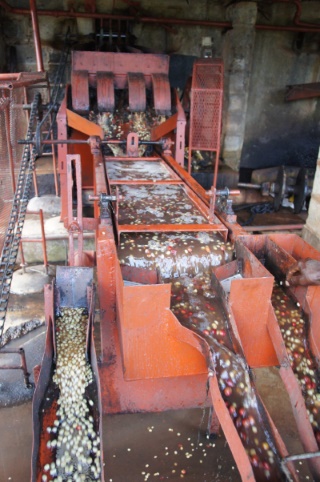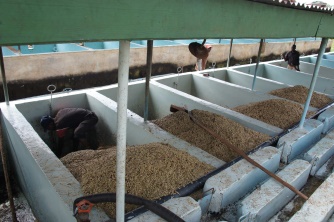Wet processed coffee
The wet process (also called "washed") requires the use of specialized equipment and significant amounts of water. Done correctly, the inner qualities of coffee beans are better preserved in this form of treatment and lead to a more homogeneous green coffee, which produces less defective beans. Wet processed coffee is therefore considered to be of higher quality and is traded at a higher price level.
The wet processing consists of the following steps:
- Sorting & Cleaning
- Pulping
- Fermentation
- Coffee washing & drying
Sorting & Cleaning

Coffeepulper and sorting
Even after careful harvesting, there will be a certain number of partially dried and immature cherries, as well as stones and dirt among the ripe cherries. As in the dry process, the sorting and cleaning of the cherries is necessary and is done immediately after the harvest. This operation can be done by washing the cherries in tanks with flowing water. Sieves can be used to separate the mature and immature, large and small cherries.
Pulping

Coffee Pulper
After sorting and cleaning, the pulp is removed from the cherry. This process is the main difference between dry and wet methods, as the flesh is separated from the fruit before drying. The step is referred to as "pulping".
The pulping is done by machine - the cherries are pressed between fixed and moving surfaces. The flesh and the skin of the fruit remain on one side, the beans still enclosed in their parchment on the other side. The distance of the moving surfaces is constantly adapted so that the beans are not damaged.
Afterwards, the beans are separated of unwanted residues (incomplete pulped cherries, as well as larger pulp residues) using screening machines. From the screening machine, the beans then continue to water channels, where a further separation of residues is carried out by means of flotation. As this process occurs mechanically some pulp, which adheres to the parchment (which surrounds the bean), will still adhere on the bean.
Fermentation

Coffee fermentation tank
To remove this remaining pulp, the beans are placed in large fermentation tanks, in which the residues can be broken down by natural enzymes, and then easily rinsed away.
This fermentation process must be carefully monitored to avoid unwanted sour flavors. For most coffees this step takes between 24 and 36 hours..
Coffee washing and drying

Coffee washing
When the fermentation is complete, the coffee is washed thoroughly with clean water in tanks or in special washing machines.
Wet parchment coffee consists of approximately 57% humidity. To reduce the moisture to no more than 12.5% the beans are dried either in the sun, in a mechanical dryer, or by a combination of the two methods.
Sun drying is done on extended flat concrete / brick surfaces or dry tables of fine mesh wire netting. The beans are placed in a layer of 2 to 10 cm and often turned to ensure uniform drying.

Coffee drying
The drying process takes between 8-10 days, depending on ambient temperature and humidity. After drying, the coffee (coffee processed by this method is known as "parchment coffee") is stored until export. Before exporting in a last step the parchment is removed and the beans classified according to various quality criteria.
Application
With the exception of the above mentioned countries, the wet process is generally used for Arabica coffee.
